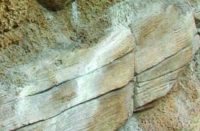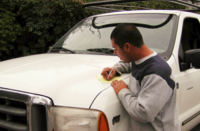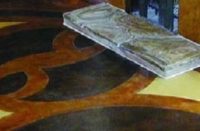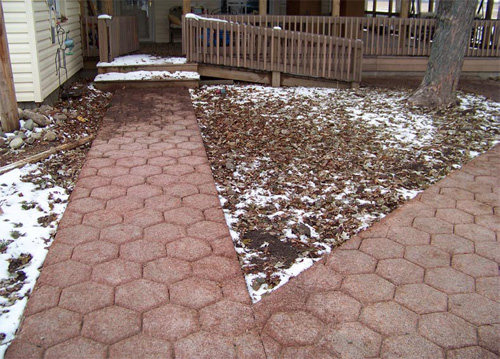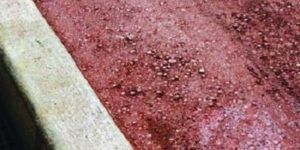Here are five ways that decorative concrete contractors can adapt decorative techniques to pervious concrete.
Ensure there is enough hydration-stabilizing admixture (HSA) in the mix to allow an appropriate time to perform the stamping process. An average dose of HSA for 70 F to 80 F is 10 to 14 ounces per 100 pounds of cementitious material. I typically add at least 6 to 8 more ounces per 100 pounds of cement. This addition usually buys me another one to two hours of extra working time. It is critical to not disturb the pervious material once hydration begins.
Alter your staining processes. All stains will work on pervious, provided soybean oil is not already on the surface. That said, the use of acid stain on pervious will require a lot of neutralizing material due to the nature of the pervious surface.
Typically, both acid and water-based stains will require some sort of sealer to hold the color permanently. The problem is acrylic sealer applied by normal methods will clog the slab. Bean oil with a pigment pack (like the kind I sell) colors and seals all at once.
If you’re not using a pervious-specific colorant, once a color is chosen from any color chart, the contractor needs to buy a color two hues darker for application. Pervious concrete has so many pores in it that the texture of the concrete essentially absorbs light rather than reflecting it back to the eye, and colors don’t deepen like they would normally. Colors appear lighter on pervious than they do on normal concrete.
When staining to achieve a Solar Reflectance Index number of 29 or higher, the contractor applies product as the pervious slab is being placed and again (from a different direction) after the plastic is removed.
 Choose your aggregate carefully when staining. In Indiana, we have excellent river gravel. Its absorption is such that it won’t accept stain. In these cases I choose our crushed limestone, which can be stained.
Choose your aggregate carefully when staining. In Indiana, we have excellent river gravel. Its absorption is such that it won’t accept stain. In these cases I choose our crushed limestone, which can be stained.
Aggregate choices can make a stamping job, too. The aggregate that works for a parking lot may be too coarse for stamping. Also, smaller rounded aggregate stamps the easiest.
When staining a stamped slab where all the “pavers” I’ve created will be the same color and the joints are clean, I’ll grab a mortar bag and fill it with play sand. I then apply the play sand in the joint as desired. I straighten the sand with a paintbrush and then spray the stain over the entire slab. The sand won’t let the stain penetrate. After the proper color is achieved, I shop-vac the sand from the joints.
